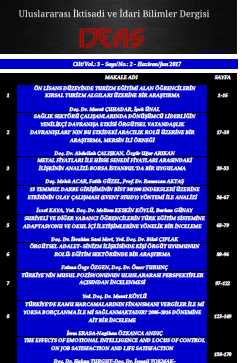SAĞLIK ÇALIŞANLARININ BENİMSEDİKLERİ LİDERLİK TARZLARI İLE ÖRGÜTSEL DAVRANIŞLARIN İLİŞKİSİ
Bu çalışmada hastane çalışanlarının örgüt içerisinde benimsedikleri liderlik tarzlarının, yaşın, cinsiyetin ve hastanede çalışılan toplam sürenin örgütsel davranışlar üzerindeki etkisi incelenmiştir. Bu kapsamda, örgütsel davranış boyutları çalışanların iş ve pozisyon tanımlamaları, memnuniyet düzeyleri, motivasyon düzeyleri, örgüt içi liderlik duygu ve düşünceleri ile kişilik yapıları olarak belirlenmiştir.Araştırma sonuçlarına göre; yaşın, cinsiyetin ve şirkette geçirilen sürenin örgütsel davranış boyutları üzerinde anlamlı etkisinin olmadığı saptanmıştır. Bunun yanı sıra, benimsenen liderlik tarzları memnuniyet, motivasyon, liderlik yapısı ve kişilik üzerinde anlamlı bir şekilde etkili olmaktadır. Bu noktada, transformasyonel ve paternalist liderlik tarzlarını benimseyen çalışanların memnuniyet ve motivasyon düzeylerinin daha yüksek olduğu saptanmıştır.
Anahtar Kelimeler:
Liderlik Tarzları, Örgütsel Davranış, İçsel Motivasyon, Dışsal Motivasyon
THE RELATIONSHIP BETWEEN LEADERSHIP STYLES AND ORGANIZATIONAL BEHAVIORS ADOPTED BY HEALTH WORKERS
In this study, the effects of the leadership styles adopted by the hospital employees in the organization, age, gender and the total time worked in the hospital on organizational behaviors were examined. In that extent, the scales for organizational behavior patterns are determined as job description, satisfaction, motivation, the feeling of leadership and personality. According to the results, it is found out that age, gender and total time spent in the hospital have no effect on organizational behavior scales. On the other hand, the organizational behavior patterns are significantly predicted by the adopted leadership styles. Here, the employees who have adopted the transformational and paternal leadership styles are found to have significantly higher levels of satisfaction and motivation.
Keywords:
Leadership, Behavior,
___
- Avolio, B. J., & Yammarino, F. J. (Eds.). (2013). Transformational and charismatic leadership: The road ahead. Emerald Group Publishing.
- Blake R.R. and McCanse A.A., Leadership Dilemmas—Grid Solutions, Houston: Gulf Publishing, 1991.
- Bum, C. H., & Shin, S. H. (2015). The Relationships between Coaches’ Leadership Styles, Competitive State Anxiety, and Golf Performance in Korean Junior Golfers. Sport Science Review, 24(5-6), 371-386.
- Clark, D.R., 2004. Leadership Questionairre. < http: www. Skaqitwatershed.org.
- Clarke, S. (2013). Safety leadership: A meta‐analytic review of transformational and transactional leadership styles as antecedents of safety behaviours.Journal of Occupational and Organizational Psychology, 86(1), 22-49.
- Çalışkan, A. (2018). Dönüşümcü Liderliğin İş Performansına Etkisi: Lider Üye Etkileşimi Ve Örgütsel Bağlılığın Aracılık Rolü, Toros Üniversitesi İİSBF Sosyal Bilimler Dergisi, 5(8), 104-140.
- Du, S., Swaen, V., Lindgreen, A., & Sen, S. (2013). The Roles of Leadership Styles in Corporate Social Responsibility. Journal of business ethics, 114(1), 155-169.
- Dukarska, M., O'Dwyer, B., & Crowley, B. (2014, January). The Social Learning Process does not have a timeframe in a Business Start-up Programme. InICSB World Conference Proceedings (p. 1). International Council for Small business (ICSB).
- Gökçora, İsmail Haluk Toplumsal Yaşamımızda ve Türk Bilim-Dünyasında “Profesyonel ve Profesyonellik” Kavramlarına Değin. Bilgi Dünyası, 2005, vol. 6, n. 2, pp. 237-250.
- Hersey, P., & Blanchard, K. H. (1993). Management of organizational behavior: Utilizing human resources . Prentice-Hall, Inc.
- Hogg, M. A., & Terry, D. J. (Eds.). (2014). Social identity processes in organizational contexts. Psychology Press.
- Jackson, D., & Wilton, N. (2016). Career management attitudes among business undergraduates. Australian Journal of Career Development, 25(1), 7-22.
- Javed, H. A., Jaffari, A. A., & Rahim, M. (2014). Leadership Styles and Employees’ Job Satisfaction: A Case from the Private Banking Sector of Pakistan. Journal of Asian Business Strategy, 4(3), 41-50.
- Maloney, S., Chamberlain, M., Morrison, S., Kotsanas, G., Keating, J. L., & Ilic, D. (2013). Health professional learner attitudes and use of digital learning resources. Journal of medical Internet research, 15(1), e7., 1-9.
- Men, L. R., & Stacks, D. W. (2013). The impact of leadership style and employee empowerment on perceived organizational reputation. Journal of Communication Management, 17(2), 171-192.
- Moore, C., Detert, J. R., Klebe Treviño, L., Baker, V. L., & Mayer, D. M. (2012). Why employees do bad things: Moral disengagement and unethical organizational behavior. Personnel Psychology, 65(1), 1-48.
- Northhouse P.G., Leadership-Theory and Practice, Sage Publications, 2007.
- Owens, R. G., & Valesky, T. C. (2013). Organizational Behavior in Education: Pearson New International Edition: Leadership and School Reform. Pearson Higher Ed.
- Parris, D. L., & Peachey, J. W. (2013). A systematic literature review of servant leadership theory in organizational contexts. Journal of business ethics, 113(3), 377-393.
- Pentland, B. T., & Hærem, T. (2015). Organizational Routines as Patterns of Action: Implications for Organizational Behavior. Annu. Rev. Organ. Psychol. Organ. Behav., 2(1), 465-487.
- Pinder, C. C. (2014). Work motivation in organizational behavior. Psychology Press.
- Price, G., & Van der Walt, A. J. (2013). Changes in attitudes towards business ethics held by former South African business management students. Journal of business ethics, 113(3), 429-440.
- Taplin, S. H., Foster, M. K., & Shortell, S. M. (2013). Organizational Leadership For Building Effective Health Care Teams. The Annals of Family Medicine, 11(3), 279-281.
- ISSN: 2149-5823
- Başlangıç: 2015
- Yayıncı: Ömer TURUNÇ
Sayıdaki Diğer Makaleler
İŞ PERFORMANSI, GÖREV PERFORMANSI, BAĞLAMSAL PERFORMANS: BİR ÖLÇEK GELİŞTİRME ÇALIŞMASI
Abdullah ÇALIŞKAN, Emine Özlem KÖROĞLU
SAĞLIK ÇALIŞANLARININ BENİMSEDİKLERİ LİDERLİK TARZLARI İLE ÖRGÜTSEL DAVRANIŞLARIN İLİŞKİSİ
Semra ATMACA, Abdullah Çetin YİĞİT
ÖRGÜTSEL ADALET ALGISININ ÖRGÜTSEL BAĞLILIK VE TÜKENMİŞLİĞE ETKİSİ
Merve Büşra ALTUNDERE, Saliha KARAGÖZ
TÜRKİYE VE BRICS ÜLKELERİ ÜZERİNE SEKTÖREL BİR YOĞUNLAŞMA ANALİZİ
Zeynep AKTAŞ ÇİMEN, Levent KÖSEKAHYAOĞLU
İŞ VE İŞ YERİNDE CESARET KONULU MAKALELERİN BİBLİYOMETRİK ANALİZİ
TÜRKİYE'DE YEREL YÖNETİMLERDE SÜRDÜRÜLEBİLİRLİK RAPORLAMASI: DEĞERLENDİRMELER VE ÖNERİLER
